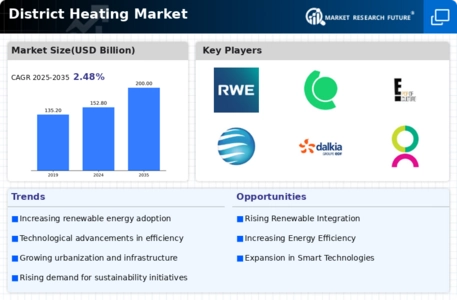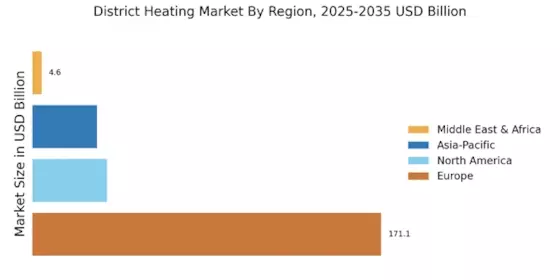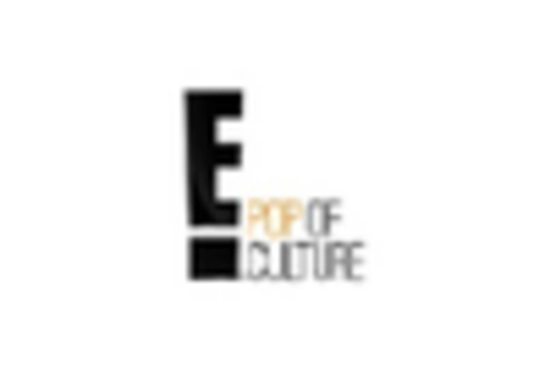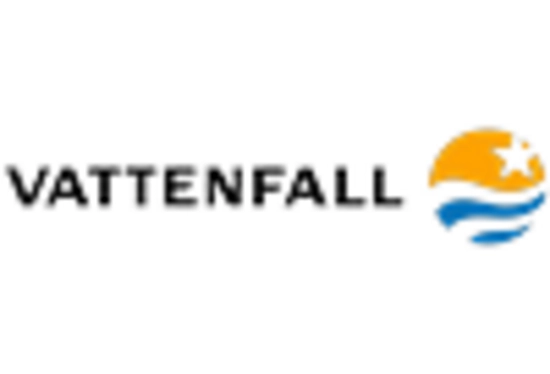Rising Demand for Energy Efficiency
The District Heating Market Industry is experiencing a notable increase in demand for energy-efficient solutions. As urbanization accelerates, cities are seeking ways to optimize energy consumption and reduce greenhouse gas emissions. District heating systems, which utilize centralized heating sources to distribute thermal energy, offer a compelling solution. According to recent data, district heating can achieve efficiency levels of up to 90%, significantly outperforming traditional heating methods. This heightened focus on energy efficiency is likely to drive investments in district heating infrastructure, as municipalities aim to meet sustainability targets and enhance energy security. Furthermore, the integration of smart technologies into district heating systems may further improve efficiency, making them more attractive to consumers and businesses alike.
Increasing Urbanization and Population Growth
The District Heating Market Industry is poised for growth due to the ongoing trends of urbanization and population growth. As more individuals migrate to urban areas, the demand for reliable and efficient heating solutions escalates. District heating systems are particularly well-suited for densely populated regions, where they can provide heating to multiple buildings from a centralized source. Recent statistics indicate that urban areas are expected to house over 68% of the world’s population by 2050, creating a substantial market opportunity for district heating providers. This demographic shift necessitates the development of robust heating infrastructure, which district heating systems can effectively fulfill. Consequently, the increasing urban population is likely to bolster the demand for district heating services, driving market expansion.
Supportive Government Regulations and Policies
The District Heating Market Industry benefits from a favorable regulatory environment that encourages the adoption of district heating systems. Governments worldwide are implementing policies aimed at reducing carbon emissions and promoting renewable energy sources. For instance, many countries have established targets for carbon neutrality, which often include the expansion of district heating networks as a means to achieve these goals. Financial incentives, such as subsidies and tax breaks for district heating projects, further stimulate market growth. Recent reports suggest that investments in district heating infrastructure could reach billions of dollars in the coming years, driven by supportive government initiatives. This regulatory backing not only enhances the attractiveness of district heating systems but also fosters innovation and technological advancements within the industry.
Technological Innovations in Heating Solutions
The District Heating Market Industry is witnessing a wave of technological innovations that enhance the efficiency and reliability of heating solutions. Advances in heat generation technologies, such as combined heat and power (CHP) systems and heat pumps, are transforming the landscape of district heating. These innovations enable the integration of renewable energy sources, such as solar and biomass, into district heating networks, thereby reducing reliance on fossil fuels. Furthermore, the implementation of smart grid technologies allows for better management of energy distribution, optimizing performance and reducing costs. As these technologies continue to evolve, they are likely to attract further investment in district heating infrastructure, positioning the industry for sustained growth in the coming years.
Growing Awareness of Environmental Sustainability
The District Heating Market Industry is increasingly influenced by the growing awareness of environmental sustainability among consumers and businesses. As climate change concerns rise, there is a collective push towards adopting cleaner energy solutions. District heating systems, which can utilize renewable energy sources and waste heat, present a viable option for reducing carbon footprints. Recent surveys indicate that a significant portion of consumers is willing to pay a premium for sustainable heating solutions, reflecting a shift in market preferences. This heightened awareness is likely to drive demand for district heating services, as more stakeholders recognize the environmental benefits associated with these systems. Consequently, the district heating market may experience accelerated growth as sustainability becomes a central tenet of energy consumption.


















Leave a Comment